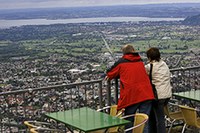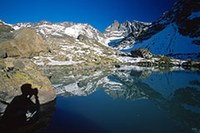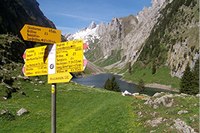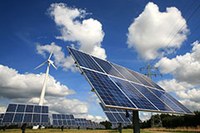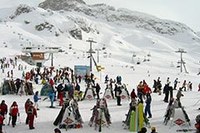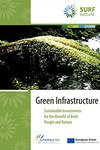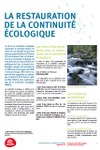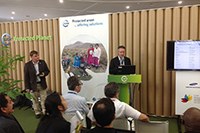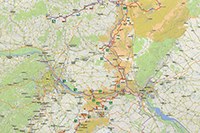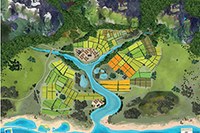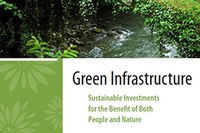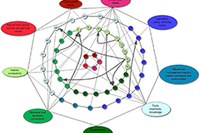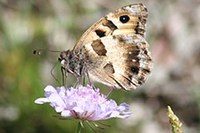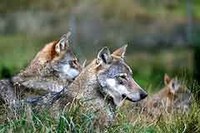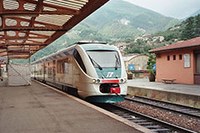Articles
Macro-region: Europe goes a step further
The European Parliament has adopted a resolution on a macro-regional strategy, while the Alpine Space Programme submitted an expert report to the European Union. Read More…
CIPRA's point of view: Shaping the macro-region Alps according to the Alpine Convention - but better
Many people in the Alps are afraid of being marginalised by the surrounding metropolitan areas. But the expansion of the sphere of action and influence also offers numerous opportunities - if we rise to the challenge, CIPRA believes. Read More…
CIPRA's Annual Conference: "The Alps as a Water Trough"
The "blue gold" of the Alps is limited in quantity and thus in high demand for use as drinking water, snow or electricity. At its Annual Conference in Bozen/Bolzano in October 2013, CIPRA will be asking who has the right to this elixir of life and who has responsibility for it. Read More…
A simple way to communicate climate change adaptation
There exist solutions for dealing with the consequences of global warming. But how can they be successfully communicated? A guide now gives answers for the Alpine Space in 7 steps. Read More…
New strategy for the Alpine Space Programme
What does the future hold for the Alps? Which projects should the European Union co-finance? A study now provides answers and establishes a framework for the new funding period for the European Alpine Space Programme. Read More…
Energy discussed between mountain and lake…
The Alpstar mid-term conference took place from April 25th to 26th 2013, in the city of Grassau in the beautiful region of the Achental. Read More…
A public-shared sustainable energy action plan
The Natural Regional Park of Queyras (France, PACA region) launched its own sustainable energy action plan in May 2013. Its primary objective is to be shared among citizens and local stakeholders. Read More…
Energy efficiency in ski resorts!
How to reduce energy consumption and green house gases (GHG) emissions in ski resorts? A pilot action in the Pays Serre-Ponçon Ubaye Durance (Pays SUD, France). Read More…
Launch of the Alpstar mobility network in Vorarlberg
Alpstar project partner Vorarlberg launches a mobility network with 9 companies mainly from the producing industry in Vorarlberg. The network partners will share their experiences in the network and they will work on solutions for upcoming challenges within the field of mobility. Read More…
Launch of the International Connectivity Conservation Network
Connecting habitats around the world requires the commitment of a great number of individuals. To help these persons in their work, the World Commission on Protected Areas has established the International Connectivity Conservation Network. Read More…
Alps and beyond: better corridors towards the Carpathians and the Mediterranean region
Ecological networks are important within certain geographical areas, such as the Alps, and also with neighbouring regions. Several projects are working to ensure that the Alps are better connected with their surroundings. Major steps have been undertaken in the Alps-Carpathians corridor and in the area connecting the Alps with the Mediterranean region. Read More…
Natural forests for woodpeckers, beetles and bats
The new Austrian project, "Network Natural Forests", intends to contribute to the protection of biodiversity by connecting its forest habitats via two elements: close-to-nature stepping stones and the co-operation of different protected areas. Read More…
Nature-friendly tourism and connected habitats in the Rhaetian Triangle
Supporting the implementation of an ecological network continues to be a major issue in the Swiss region of the Lower Engadine. The new "Colliar" project intends to improve co-operation on regional initiatives by different sectors. Read More…
Better ecological corridors and fewer accidents involving animals on Swiss roads
The Federal Council has drawn positive conclusions as regards the status of ecological corridors in Switzerland. A pilot project has tested how to successfully reduce collisions between animals and cars. The upcoming research field of landscape genetics provides new insights for the planning and implementation of ecological networks. Read More…
France paves the way for its green and blue infrastructure
After more than a year of discussions, France officially established its "trame verte et bleue" ecological network with the publication of a decree at the end of 2012. This Alpine country now has legal rules on how to define and implement its green and blue infrastructure. Read More…
Win-win for nature, economy and society: more green infrastructure throughout Europe
Since May the countries of the European Union have received guidelines on how to promote green infrastructure. The European Commission has adopted its strategy on this topic with the aim of better integrating natural processes into spatial planning and strengthening the benefits of intact ecosystems for the economy and society. In addition, Natura2000 and Emerald sites have been further recognized as major elements in an ecological network. Read More…
Alpine Convention strengthens co-operation between neighbouring countries
With its new presidency, the "Ecological Network" Platform of the Alpine Convention is now continuing its work. In focus over the next two years are cross-border co-operation between neighbouring states and activities in the pilot regions. Read More…
The cameras are rolling for hermits and fire salamanders
What can be done to preserve the diversity of plant and animal species in the Alps? CIPRA provides some answers in the short film "For hermits and fire salamanders - How municipalities connect habitats in the Alps". The film can be seen online and at different locations in the Alps. Read More…
Ecological Continuum in the Alps: from 50 questions to a few concerted actions
How will demographic change affect the future of the ecological continuum? And which indicators of species and habitats can be used to assess an ecological network? These are just two of the 50 questions put together by scientists, politicians and environmentalists from all the Alpine lands. Read More…
Making mobility the main theme
Why do most of those working in the Alpine Rhine Valley drive to work in their own cars - despite excellent cycle ways and a good public transport network? The Alpstar partners in Liechtenstein, St. Gallen and Vorarlberg investigate. Read More…
End of the line for the Tende railway?
New tunnels crossing the Alps are feverishly being built elsewhere, but the Tende line between Turin and Nice is due to be closed. People on both sides of the border are protesting, however. Can this historic railway line still be saved? Read More…
Oh...!
... Honesty pays off in the end. This must have been the thought of a 90-year old inhabitant of the Canton of Wallis who had spent his entire life blasting away at animals against the law. Read More…

